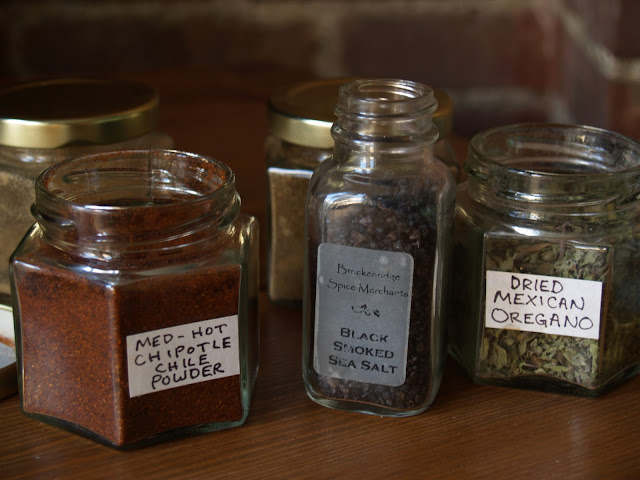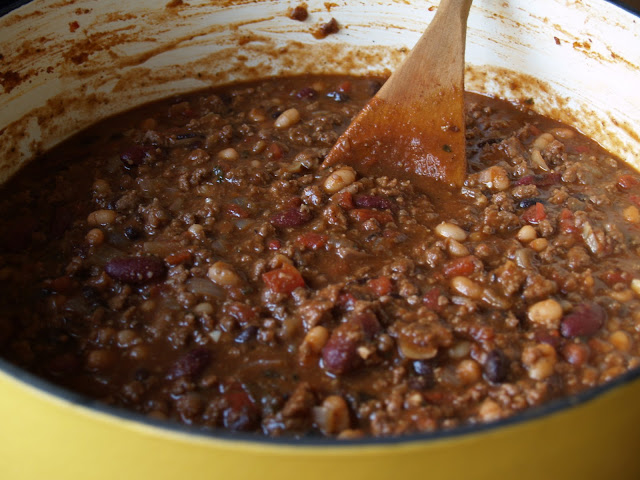I've been in such a stewy mood lately. Here's a lovely recipe for that classic peasant food, shepherd's pie. Lamb leg can be a bit pricey, but the rest of the ingredients called for in this recipe are very inexpensive. And believe me, it's worth it for the tender pieces of moist lamb in every bite!
I asked my butcher for bone-in leg of lamb, but when I got home there was no bone to be found. Argh! The bone imparts so much flavor in a long braise, so I was a bit disappointed (yes, I thought of marching back and asking where my bone was, but I decided I wasn't quite ready to turn into a pushy Upper West Side grandmother). I had intended to let the leg braise overnight in the oven and then once the meat was nearly falling off the bone, shred it. Instead, being short on time and lacking my bone, I decided to dice the meat and braised it for an hour which still gave me incredible results. I also substituted the traditional mashed potato topping for mashed turnips. They are naturally buttery and a bit lighter and fluffier than mashed potatoes. I was in the mood for them so that's what I've used here, but feel free to use potatoes if you please.
LAMB
SHEPHERD’S PIE
Adapted from an Anne Burrell recipe
Ingredients:
For the lamb:
Olive oil
3 lb. boneless lamb leg (trimmed of excessive fat), cut into ½ inch dice (see notes below)
Kosher salt
Kosher salt
½ cup all-purpose flour
2 medium-sized yellow onions, chopped
2 carrots, peeled and cut into ¼-inch dice
1 parsnip, peeled and cut into ¼-inch dice
3 ribs celery, chopped
2 cloves garlic, minced
¼ cup tomato paste
1 cup red wine
3 to 4 cups chicken stock
2 bay leaves
10 sprigs fresh thyme, tied with butcher's twine
1 sprig fresh rosemary, minced
For the turnip mash:
2 1/2 lbs. turnips (rutabagas work well too), peeled and cut into 1-inch cubes
4 tbsp. unsalted butter
1/4 cup heavy cream
Salt and pepper to taste
Coat the bottom of a large Dutch oven (or a wide deep pan
with a lid) with olive oil and set over medium-high heat. Season the lamb
generously with salt and toss in the flour until completely coated. Add the
lamb to the pot and brown well on all sides (do this in batches to ensure even
and dark browning). Remove the lamb from the pot and set aside. Drain off all
but two tablespoons of the olive oil in the pan and replenish with a tablespoon
or two of fresh oil.
Return the pot to medium heat and add the onions, carrots,
parsnips, and celery. Season with salt and, stirring often, cook until the
vegetables are soft, about 8 to 10 minutes. Add the garlic and cook 2 to 3
minutes more. Return the lamb to the pot and stir well to combine. Add the tomato
paste and cook until it begins to brown, about 2 to 3 minutes.
Add the wine and cook until it reduces by half. Add just
enough stock to cover the surface of the lamb, and taste to adjust seasonings,
adding more salt if necessary. Add the bay leaves, rosemary and thyme bundle. Scrape up any brown bits stuck to the bottom of the pan. Bring the
stock to a boil and then reduce to a simmer. Partially cover the pot and simmer
for about 1 hour, or until the lamb is extremely tender. Stir every so often to prevent scorching.
Meanwhile, make the turnip mash. Blanch the turnips in boiling water or steam them until soft and easily pierced with a fork, about 15 minutes. Transfer the turnips to a food processor fitted with a steel blade and process until completely pureed. Place the puree in a fine mesh strainer set over a small bowl. Using a spatula, work out any excess water and discard. Transfer the turnips to a large mixing bowl and add butter, cream, salt and pepper. Stir well to combine. Taste to adjust seasonings, adding more salt if necessary. Cover with foil and set aside.
Remove the lid from the lamb and continue to
simmer for about 15 minutes more to reduce the stock level a bit. The lamb
mixture should be thick and stew-like when done. Remove the bay leaves and herb
bundle and discard. Taste again to adjust seasonings.
Preheat the broiler. Transfer lamb to a wide, flat ovenproof
baking dish. Evenly spread the mashed turnips over the lamb mixture. Place the
baking dish under the broiler until the turnips turn a golden brown and develop
a delicate crust.
Yield: about 8 servings
Yield: about 8 servings
Notes:
- If you plan on making this dish for a dinner party, a fun way to dress it up a bit is by making individual pies in small souffle dishes (as you can see pictured above). Cook and assemble your shepherd's pies the night before and simply heat them through (and brown them under the broiler) just before you're ready to eat.
- If using bone-in lamb leg, save the bone and add it to the pot as it simmers.
- Feel free to add frozen peas to this as well. Incorporate them after your lamb has cooked for the full hour, before continuing on.




















































